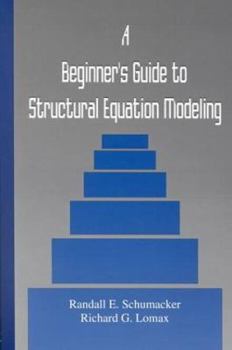A Beginners Guide Structural P
Select Format
Select Condition 
Book Overview
Noted for its crystal clear explanations, this book is considered the most comprehensive introductory text to structural equation modeling (SEM). Noted for its thorough review of basic concepts and a... This description may be from another edition of this product.
Format:Paperback
Language:English
ISBN:0805817670
ISBN13:9780805817676
Release Date:June 1996
Publisher:Psychology Press
Length:304 Pages
Weight:1.10 lbs.
Dimensions:0.7" x 6.0" x 9.2"
Customer Reviews
5 ratings
easy to follow
Published by Thriftbooks.com User , 19 years ago
This is quite easy to follow for beginners but you def. need a good stats background to do so!
Easy to read and understand; needs a second edition
Published by Thriftbooks.com User , 20 years ago
No one expects statistics to be easy reading, especially when it concerns complicated models such as structural equation modeling (SEM). Nevertheless, this book manages to do just that. Schumacker and Lomax have successfully put together a guide that explains to beginners (like myself) in simple terms how the whole thing works. As with most books that treat complex models, some basic knowledge of statistics is preferable before you begin to read it. But if your statistics is rusty and you have only vague impressions of probability sketches in your memory, fear not! Schumacker and Lomax are kind to us poor souls, and begin by introducing some basics in chapter 1 to prod your memory: terminology, variable scales, how to treat missing data, outliers and normality. And in chapter 2, they discuss correlation and covariance. Before talking about structural equation models, Schumacker and Lomax dedicate chapter 3 to a number of statistical methods on which SEM is built. This chapter gives a basic overview of regression, path analysis and factor analysis. The review of these methods helps you to understand SEM better later on. They also provide an excellent understanding of the methods, in case you have not used them before or it's been a while ... The rest of the guide covers SEM: how to develop and measure a model (chapters 4 and 5), how the model parameters are estimated and how you can check for reliability and validity (chapter 6), and checking for goodness of fit of your model (chapter 7). In chapter 8, you are shown some examples of computer outputs by two software packages that can conduct SEM, EQS5 and LISREL8-SIMPLIS. Chapter 9 goes into more detail on models and diagrams (regression, analysis of covariance, path, measurement and structural models). For those that feel by this point that they've gained enough experience, advanced topics such as cross validation, simulation, bootstrap and jacknife methods as well as multiple same and interaction models are covered in chapter 10. And for the super-keen, the technical bits are covered in chapter 11 (health warning: you better be up to speed on matrix algebra). The great thing about this book is that you most likely will be able to run models and interpret results by chapter 7, and you don't need to go into the nitty-gritty if you don't want to. On the other hand, the details are there if you need them. In essence, the authors start at the beginning, building up slowly until you are able to handle a basic model, before going into more complex issues. One drawback, I have found, is that this book was published in 1996. That's nearly a decade ago, and (fortunately) computer power and statistical modeling has come a long way since then. The authors, for example, are convinced that WordPerfect is the software of choice for word processing and that at some point in the future it would be possible to copy and paste diagrams into a word processing program. We've come a long way since then. Tod
Good for a first course.
Published by Thriftbooks.com User , 22 years ago
Schumacker and Lomax make for a good first course in SEM. Although they are somewhat less technical than Bollen (1989), they are a little more up-to-date, and very good reading for a beginning student of SEM. I found the sections on confirmatory factor analysis and identification very useful.
A very good book
Published by Thriftbooks.com User , 25 years ago
This is a very good book about SEM for the beginners and advanced. The book gives a clear and concise principles and examples about SEM. This book definitely enables the readers clearly understand the subject.
Excellent for a first glance
Published by Thriftbooks.com User , 25 years ago
The authors present remarkably the basic principles and concepts underlying SEQ, but also give numerous notions about technical aspects. An Excellent book, even for people who are not very keen on statistical writings.





